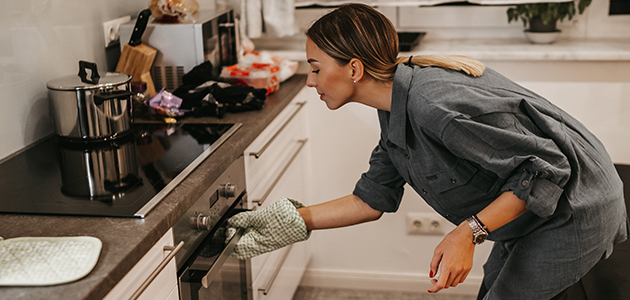Have you been watching friends post pictures of bakery-worthy homemade bread with amazement (and perhaps a twinge of envy) lately?
If you consider yourself a little challenged when it comes to baking the perfect loaf of bread, take heart. Know that you’re not alone, and sometimes all it takes is a few simple tips to help you turn your mediocre loaf into a culinary masterpiece!
- Weigh your flour. Weighing is the most accurate way to ensure that you’re using exactly the right amount of flour. If you choose to go by volume instead, make sure not to scoop the flour directly from the bag using your measuring cup. This compacts it, which means you may end up with more flour than you should, resulting in a dense, heavy bread. Instead, spoon the flour into a measuring cup and level it off with a knife. If your recipe only gives you a volume measure and you want to convert it, visit King Arthur Flour for an ingredient weight chart.
- Bloom your yeast. There’s no point in going through all the steps to make bread if your yeast is dead (yes, yeast is a living thing!). To find out if it’s viable, bloom your yeast by putting it in warm water with sugar (the amounts of each given in your recipe), and watching to see if it gets bubbly and foamy. Visit Feast and Farm for photos and further instructions on how to bloom your yeast.
- Learn how to knead. For a step-by-step video on how to properly knead dough, and what it should look like when it’s perfectly kneaded, visit YouTube.
- Learn how to tell when your bread has been kneaded long enough. According to kitchn, your dough is probably perfectly kneaded when you’ve been kneading it by hand for 10 – 12 minutes, or 8 – 10 minutes in a mixer. But you can also look for:
- Smoothness. Your dough should be completely smooth and slightly tacky to the touch.
- Shape. Your ball of dough should hold its shape when you lift it in your hand. If it sags between your fingers, it needs a bit more time.
- Spring. If you poke the dough with your finger and the indentation fills back in quickly, you’re good to go.
- Windowpane feature. A golf-ball sized piece of dough stretched into a thin sheet between your fingers should turn into a paper-thin film if it’s been kneaded enough. If it quickly breaks, it needs more work.
- Learn when your bread is done. As you get more experienced with baking, and work with a recipe over and over again, you’ll just “know” when it’s done. But when you’re starting out there are a few ways to ensure that your bread is perfectly baked:
- Thump it. Turn your bread out of the pan, and give the bottom of the loaf a thump with your thumb or knuckle. The bread should sound hollow. Try this every five minutes towards the end of the baking time to see how the sound changes.
- Take its temperature. An instant-read thermometer inserted into the center of the loaf should read about 190F (closer to 200F for breads enriched with butter, eggs or milk) when it’s done.1
- Don’t get too fancy at first. Try simple, basic recipes like Taste of Home’s Basic Homemade Bread until you’ve got the hang of it. After that you might want to try diving into shaped loaves like Challah.
- Try no-knead bread. If you really hate kneading and you’re happy to wait 20+ hours for a slice of homemade bread, try a no-knead recipe like this one from the New York Times. Instead of kneading, this dough simply sits for up to 20 hours while it slowly ferments (which adds a ton of delicious flavor). It’s a completely different kind of dough (which creates a chewier bread with a harder crust), so the baking method is different—but you’ll end up with a round loaf that looks like an artisan loaf you’d pay a pretty penny for at a bakery!
Remember, practice makes perfect, and even “failed” homemade bread will still fill your house with an incredible aroma while it’s baking and taste delicious slathered in butter when it’s warm out of the oven.
Bon appetit!
SOURCES
417957A CAN/US 08/20


